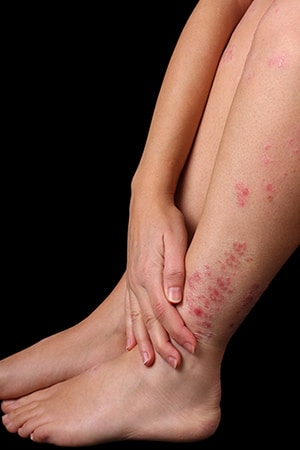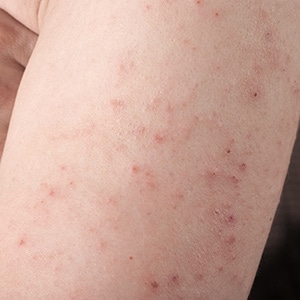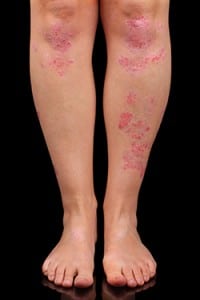By: Jessica Meyer
Patients often come in with symptoms that could fit two different diagnoses. Environmental irritants or a possible genetic skin condition could cause dry, itchy, flaky, red, or scaly skin. These two different conditions with very similar symptoms are eczema and psoriasis.
Eczema (or atopic dermatitis) is typically a reaction from irritants or environmental factors, such as dry, winter air, strong chemicals, or allergies. The eczema can be made worse by hormones or even stress. People tend to itch more during the winter, and this could cause redness, swelling, and even bleeding. Eczema shows up on the skin similar to an allergic reaction with raised bumps, dry skin, raw patches from scratching, and inflammation.
Luckily, there a few different things you can do to minimize the itching and the side effects that it causes. First of all, definitely use a good moisturizer, especially during the winter. Patients with eczema are sensitive to perfumes and other irritants, so the gentler the better. CeraVe Moisturizing Cream comes in a big tub that can be bought at the grocery store. This cream is thick enough to provide good hydration, and also gentle enough that it won’t further aggravate already irritated skin. Diet change also plays an important role in controlling eczema, because for many people symptoms are exacerbated with a food allergy. These allergic reactions can be immediate, or even a day later. It’s important to track changes in diet and changes in eczema symptoms, so that you can eliminate foods that may be triggers. For more serious cases, your dermatological provider will be able to prescribe topical medications to ease the symptoms.
Although symptoms of eczema and psoriasis may be very similar, they have some different causes. Psoriasis is something that affects your skin from within the body. It is thought to be primarily an autoimmune disease, meaning that the immune system causes inflammation in healthy body tissue. Hormones, anxiety, and stress can also cause a flare of psoriatic symptoms. There are five different types of psoriasis: plaque, guttate, inverse, pustular, and erythrodermic. Plaque psoriasis is the most common and comes in the form of raised, red, flakey patches that often have a silvery plaque- a defining characteristic of psoriasis. These patches are itchy and can be worse at times depending on your specific triggers. Plaques can occur anywhere on the body, but are most common around the elbows and knees. Compared to eczema, psoriasis more commonly occurs on the outside of the joint. There are also a few conditions that are associated with psoriasis, like psoriatic arthritis, skin cancer, depression, and a higher cardiovascular disease risk.
There are a number of things that can be done to ease the symptoms associated with psoriasis. Depending on how your body reacts with different treatments and how severe your psoriasis is, the typical first course of action is a topical medication. If your body doesn’t respond well to that, phototherapy can be done with UV light. The affected areas of skin are exposed consistently to UV light (Narrowband UVB or UVA (with psoralens)) to help control the severity. There are also options with systemic medications, like oral medications, or even the newer injectable medications you may have seen on TV. It’s important to have a treatment regimen that fits your specific case of psoriasis, for example with psoriatic arthritis where you would also need to treat the joint pain and inflammation. During a visit with your dermatologist treatment will be discussed that is best for your symptoms, lifestyle, preferences for treatment, and other medical conditions.
Both eczema and psoriasis are very common and non-contagious. Both can be managed with a routine unique to your body and symptoms. This is why it’s important to talk to your provider and find out exactly which skin issue fits your symptoms and to discuss what the best course of treatment will be.









